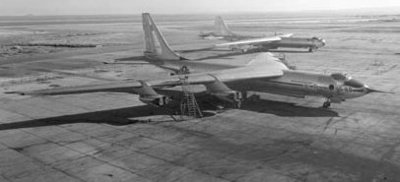Convair YB-60
|
|
The Convair YB-60 was an American experimental bomber prototype built by Convair and first flown on April 18, 1952. Proposed as an updated B-36 with swept wings and all-jet propulsion, it was originally designated XB-36G, betraying its 72% parts commonality with its piston-engined forebear. The fuselage of the two aircraft were largely identical, although the YB-60 had a longer, pointed nose with a needle-like instrument probe, instead of the B-36's rounded nose, and the tail surfaces were all-new, swept to match the wings, instead of the B-36's more antiquated design. The swept wings actually used a lot of B-36 parts, with a wedge-shaped insert at the wing root to sweep the wings back more than the B-36's wings.
The YB-60's unofficial competition for an Air Force contract was Boeing's B-52 Stratofortress. Convair's proposal was substantially cheaper than Boeing's since it involved modifying an existing design rather than starting from scratch. Like the B-52, it was powered by eight Pratt & Whitney J57-P-3 turbojets mounted in pairs in four pods suspended below the wing.
Instead of the B-36's crew of fifteen, the B-60's crew numbered only five. Defensive armament had fallen out of favor against jet-propelled, missile-armed interceptors, and the only guns were two 20 mm cannon in the tail, directed by radar.
The Convair aircraft beat the Boeing YB-52 into the air by a mere three days, but it was soon obvious that it would win few other contests against Boeing's bomber. The YB-60 was over 100 mph (160 km/h) slower than the competition, and had severe handling problems in addition. The only other contest it could win was bomb load carried, which was 72,000 pounds against 43,000 pounds (20 t) for the YB-52, but the Air Force didn't see the need for it.
Accordingly, the flight test program was cancelled on January 20, 1953 with 66 flying hours accumulated. The second prototype was never completed. The airframe was complete, but it was never provided with engines or much other equipment. The aircraft were formally accepted by the Air Force in 1954, since Convair had completed its prototype contract satisfactorily, but the aircraft never flew again and both were scrapped by July of that year.
Specifications (YB-60)
General characteristics
- Crew: 5
- Length: 171 ft (52.1 m)
- Wingspan: 206 ft (62.8 m)
- Height: 60 ft 6 in (18.4 m)
- Wing area: 5,239 ft² (486.7 m²)
- Empty: 153,016 lb (69,407 kg)
- Loaded: 160,000 lb (73,000 kg)
- Maximum takeoff: 300,000 lb (140,000 kg)
- Powerplant: 8× Pratt & Whitney J57-P-3 turbojets; 8,700 lbf (39 kN) thrust each
Performance
- Maximum speed: 508 mph (818 km/h)
- Cruising speed: 435 mph (700 km/h)
- Combat range: 2,920 miles (4,700 km)
- Ferry range: 8,000 miles (13,000 km)
- Service ceiling: 53,300 ft (16,200 m)
- Rate of climb: 1,060 ft/min (323 m/min)
- Wing loading: 31 lb/ft² (150 kg/m²)
- Thrust/weight: 0.44
Armament
- 2× 20 mm cannon in tail
- 72,000 lb (33,000 kg) of bombs
Related content
Related development: Convair B-36
Comparable aircraft: B-52 Stratofortress
Designation sequence: B-57 - B-58 - XB-59 - YB-60 - TM-61 - SM-62 - XGAM-63
Related lists: List of military aircraft of the United States - List of bomber aircraft
|
Lists of Aircraft | Aircraft manufacturers | Aircraft engines | Aircraft engine manufacturers Airports | Airlines | Air forces | Aircraft weapons | Missiles | Timeline of aviation |

